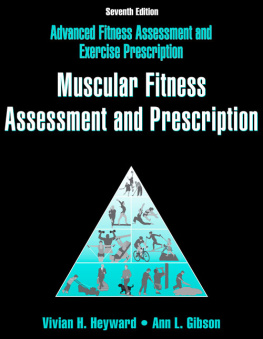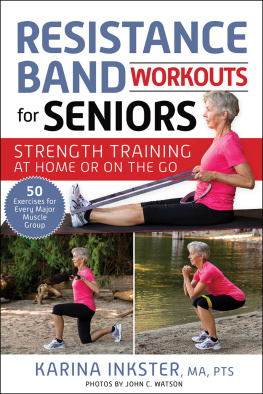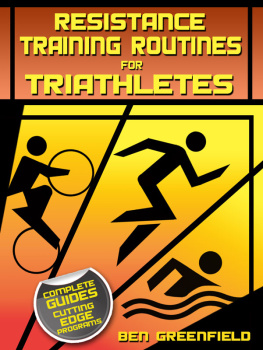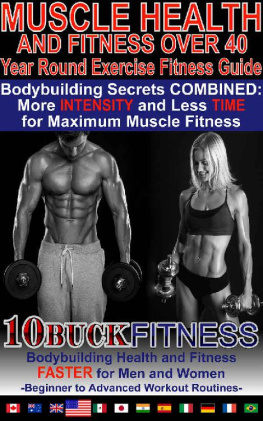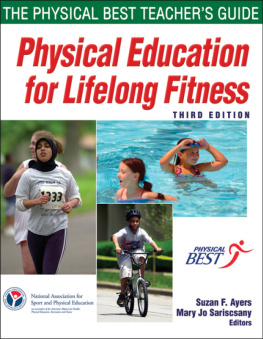ISBN-13: 978-1-4504-6820-6 (Online CE Course)
Copyright 2014 by Vivian H. Heyward and Ann L. Gibson
Copyright 2010, 2006, 2002, 1998, 1991 by Vivian H. Heyward
Copyright 1984 by Burgess Publishing Company
This e-book is a custom edition of Advanced Fitness Assessment and Exercise Prescription, Seventh Edition, published in 2014 by Human Kinetics, Inc. (Print ISBN: 978-1-4504-6600-4)
All rights reserved. Except for use in a review, the reproduction or utilization of this work in any form or by any electronic, mechanical, or other means, now known or hereafter invented, including xerography, photocopying, and recording, and in any information storage and retrieval system, is forbidden without the written permission of the publisher.
Notice: Permission to reproduce the following material is granted to instructors and agencies who have purchased Advanced Fitness Assessment and Exercise Prescription, Seventh Edition: pp. 407-416. The reproduction of other parts of this book is expressly forbidden by the above copyright notice. Persons or agencies who have not purchased Advanced Fitness Assessment and Exercise Prescription, Seventh Edition, may not reproduce any material.
The web addresses cited in this text were current as of October, 2013, unless otherwise noted.
Acquisitions Editor: Amy N. Tocco
Developmental Editor: Kevin Matz
Managing Editor: Susan Huls
Copyeditor: Joy Wotherspoon
Indexer: Nancy Ball
Permissions Manager: Dalene Reeder
Graphic Designer: Joe Buck
Graphic Artist: Julie L. Denzer
Cover Designer: Keith Blomberg
Photographs (interior): Human Kinetics unless otherwise noted
Photo Asset Manager: Laura Fitch
Visual Production Assistant: Joyce Brumfield
Photo Production Manager: Jason Allen
Art Manager: Kelly Hendren
Associate Art Manager: Alan L. Wilborn
Illustrations: Human Kinetics
Printer: Edwards Brothers Malloy
We thank the Exercise Physiology Laboratory at the University of New Mexico, Albuquerque, New Mexico, for assistance in providing the location for the photo shoot for this book.
Printed in the United States of America
10 9 8 7 6 5 4 3 2 1
The paper in this book is certified under a sustainable forestry program.
Human Kinetics
Website: www.HumanKinetics.com
United States: Human Kinetics
P.O. Box 5076
Champaign, IL 61825-5076
800-747-4457
e-mail: humank@hkusa.com
Canada: Human Kinetics
475 Devonshire Road Unit 100
Windsor, ON N8Y 2L5
800-465-7301 (in Canada only)
e-mail: info@hkcanada.com
Europe: Human Kinetics
107 Bradford Road
Stanningley
Leeds LS28 6AT, United Kingdom
+44 (0) 113 255 5665
e-mail: hk@hkeurope.com
Australia: Human Kinetics
57A Price Avenue
Lower Mitcham, South Australia 5062
08 8372 0999
e-mail: info@hkaustralia.com
New Zealand: Human Kinetics
P.O. Box 80
Torrens Park, South Australia 5062
0800 222 062
e-mail: info@hknewzealand.com
E6123
Contents
Preface
Muscular strength and endurance are two important components of muscular fitness. Minimal levels of muscular fitness are needed to perform activities of daily living, to maintain functional independence as one ages, and to partake in active leisure-time pursuits without undue stress or fatigue. Adequate levels of muscular fitness lessen the chance of developing low back problems, osteoporotic fractures, and musculoskeletal injuries.
Muscular strength and endurance are important to the overall health and physical fitness of your clients, enabling them to engage in physically active leisure-time pursuits, to perform activities of daily living more easily, and to maintain functional independence later in life. Resistance training is a systematic program of exercise for development of the muscular system. Although the primary outcome of resistance training is improved strength and muscular endurance, a number of health benefits are also derived from this form of exercise.
While resistance training has long been widely used by bodybuilders, powerlifters, and competitive athletes to develop strength and muscle size, participation in weightlifting by individuals of all ages and levels of athletic interest has increased dramatically over the past 30 yr. The popularity and widespread appeal of weightlifting exercise for general muscle conditioning challenge exercise specialists and personal trainers to develop resistance training programs that can meet the diverse needs of their clients.
Chapter 6 describes a variety of laboratory and field tests for assessing all forms of muscular strength and endurance. In addition, the chapter compares types of exercise machines, addresses factors affecting muscular fitness tests, discusses sources of measurement error, and provides guidelines for testing muscular fitness of children and older adults.
Chapter 7 shows you how to apply basic training principles to the design of resistance training programs for novice, intermediate, and advanced weightlifters. The chapter also presents guidelines for developing muscle strength, muscle endurance, muscle size, and muscle power. The chapter addresses various models of periodization, functional training exercise progressions, and guidelines for youth resistance training.
These chapters and the accompanying appendix are full excerpts from Advanced Fitness Assessment and Exercise Prescription, Seventh Edition. The books full glossary and reference list are also provided at the end of the e-book.
Chapter 6
Assessing Muscular Fitness
Key Questions
- How are strength and muscular endurance assessed?
- How does the type of muscle contraction (concentric, eccentric, or isokinetic) affect force production?
- What test protocols can be used to assess a clients muscular fitness?
- What are the advantages and limitations of using free weights and exercise machines to assess muscular strength?
- What are sources of measurement error for muscular fitness tests, and how are they controlled?
- What are the recommended procedures for administering 1-RM strength tests?
- Is it safe to give 1-RM strength tests to children and older adults?
- What tests can be used to assess the functional strength of older adults?
Muscular strength and endurance are two important components of muscular fitness. Minimal levels of muscular fitness are needed to perform activities of daily living, to maintain functional independence as one ages, and to partake in active leisure-time pursuits without undue stress or fatigue. Adequate levels of muscular fitness lessen the chance of developing low back problems, osteoporotic fractures, and musculoskeletal injuries.
This chapter describes a variety of laboratory and field tests for assessing all forms of muscular strength and endurance. In addition, the chapter compares types of exercise machines, addresses factors affecting muscular fitness tests, discusses sources of measurement error, and provides guidelines for testing muscular fitness of children and older adults.
Definition of Terms
Muscular strength is defined as the ability of a muscle group to develop maximal contractile force against a resistance in a single contraction. The force generated by a muscle or muscle group, however, is highly dependent on the velocity of movement. Maximal force is produced when the limb is not rotating (i.e., zero velocity). As the speed of joint rotation increases, the muscular force decreases. Thus, strength for dynamic movements

